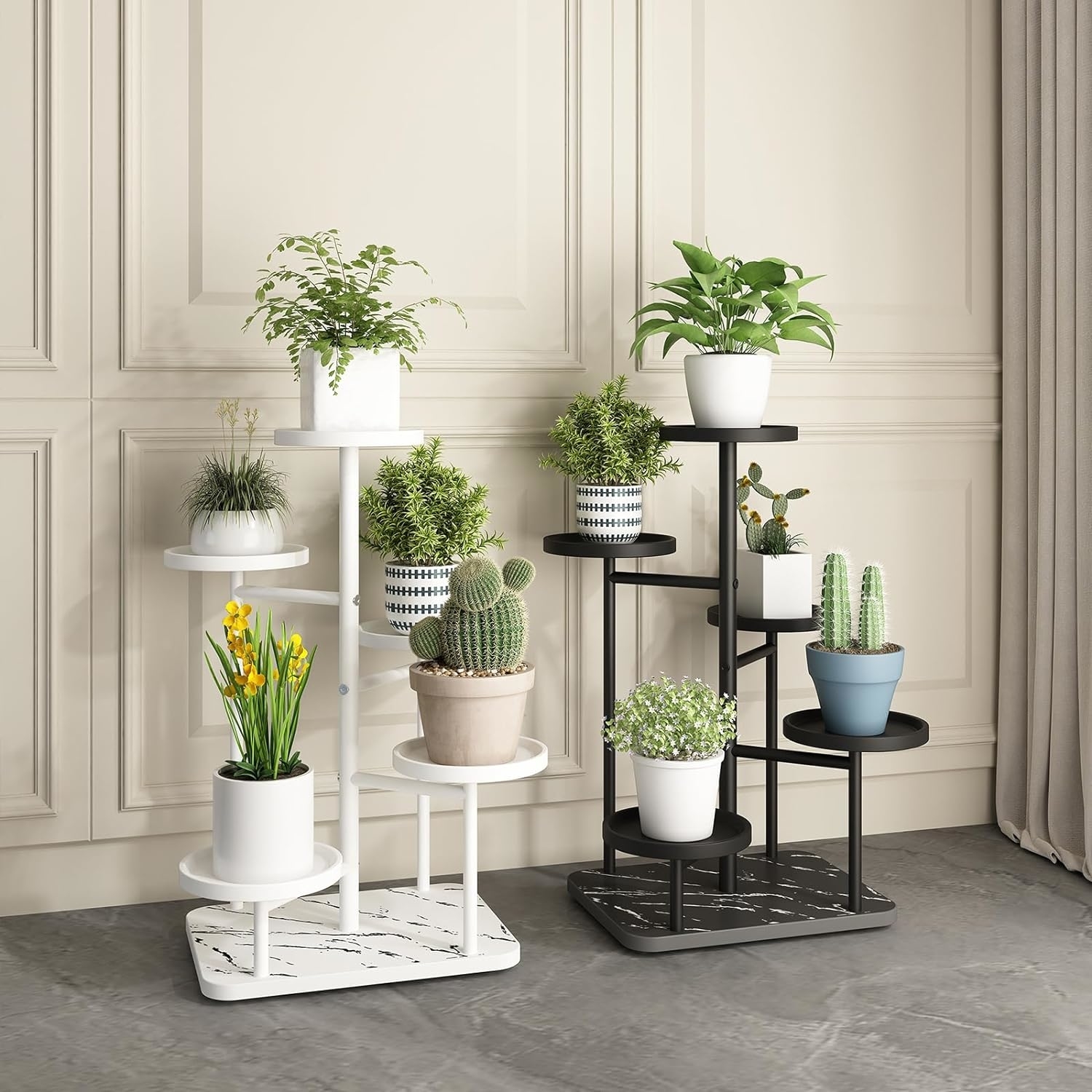Indoor plants bring life and freshness to your home. Stylish shelves can enhance this natural beauty.
Creating a green corner in your home has never been easier. With stylish indoor plant shelves, you can showcase your plants and add a touch of elegance to your décor. These shelves come in various designs and sizes, making them perfect for any space.
Whether you have a small apartment or a large house, there’s a plant shelf that fits your style. From minimalist designs to rustic wooden options, these shelves can transform any room. They not only provide a perfect spot for your plants but also help in organizing your space. Let’s explore how stylish indoor plant shelves can elevate your home’s look and feel.

Credit: www.buzzfeed.com
Benefits Of Indoor Plant Shelves
Indoor plant shelves offer numerous benefits. They not only enhance the look of your home but also improve air quality. These stylish additions can transform any room into a green oasis. Let’s explore the specific advantages of indoor plant shelves.
Enhancing Aesthetics
Indoor plant shelves can make a room look beautiful. They provide a place to display your favorite plants. These shelves come in various designs. You can choose a style that matches your home. Plants add color and life to your space. They create a relaxing atmosphere.
Improving Air Quality
Plants are natural air purifiers. They absorb carbon dioxide and release oxygen. This process improves the air quality in your home. Plant shelves allow you to keep more plants indoors. This means you can enjoy cleaner air. Some plants even remove toxins from the air. This can make your home healthier.
Choosing The Right Plants
Picking the right plants for your indoor shelves is crucial. The right plants make your space look fresh and inviting. They also thrive in your home’s conditions.
Low Maintenance Options
Low maintenance plants are perfect for busy people. They need little care but still look great. Here are some options:
- Succulents: Succulents are easy to care for and need little water.
- Snake Plant: Snake plants can survive in many conditions and purify air.
- ZZ Plant: ZZ plants are hardy and require very little attention.
Best Plants For Low Light
Low light plants are ideal for rooms with little natural light. They thrive even in darker corners of your home. Consider these plants:
| Plant Name | Key Features |
|---|---|
| Pothos | Fast-growing, trailing vines, very tolerant of low light. |
| Philodendron | Heart-shaped leaves, low light friendly, easy to grow. |
| Peace Lily | Beautiful white flowers, thrives in low light, air-purifying. |
| Spider Plant | Long, arching leaves, easy to grow, tolerates low light. |
Choose the right plants, and your indoor shelves will look stylish. They will also be easy to maintain and perfect for your home’s lighting conditions.
Selecting Shelving Materials
Choosing the right shelving material for your indoor plant display is crucial. The material affects the shelf’s durability, aesthetics, and maintenance. Let’s explore the best options for stylish indoor plant shelves.
Wooden Shelves
Wooden shelves offer a warm, natural look. They blend well with most interior styles. You can find wooden shelves in various finishes, including oak, pine, and walnut. Each type of wood offers a unique texture and color.
Here are some benefits of wooden shelves:
- Durable and can hold heavy plants.
- Easy to paint or stain to match your decor.
- Natural and eco-friendly material.
- Regularly dust the surface to prevent buildup.
- Use coasters or trays under plants to avoid water damage.
- Occasionally apply wood polish for a fresh look.
Metal And Glass Shelves
Metal and glass shelves provide a modern, sleek appearance. They are ideal for contemporary or minimalist spaces. Metal shelves are sturdy, while glass adds a touch of elegance.
| Material | Benefits | Maintenance Tips |
|---|---|---|
| Metal |
|
|
| Glass |
|
|
Both wooden and metal/glass shelves can transform your space. Choose the one that best fits your home style and maintenance preference.
Design Ideas For Plant Shelves
Designing indoor plant shelves can transform your living space. Shelves offer a unique way to display your plants while adding style to your decor. They can fit into any room, matching your home’s aesthetics. Let’s explore some stylish design ideas for plant shelves.
Minimalist Designs
Minimalist plant shelves focus on clean lines and simplicity. They often use materials like metal or light-colored wood. These shelves blend seamlessly into modern homes. They create a sleek and uncluttered look. Keep the number of plants limited to avoid a crowded appearance. Choose plants with simple, elegant leaves. This enhances the minimalist vibe.
Rustic And Vintage Looks
Rustic and vintage plant shelves bring warmth and character to a space. Reclaimed wood and wrought iron are popular materials for this style. These shelves can give a cozy, lived-in feel. They pair well with antique pots and planters. You can mix and match different sizes and shapes of shelves. This creates a unique and charming display. Add plants with trailing vines for a touch of whimsy.
Diy Plant Shelf Projects
Adding stylish indoor plant shelves can transform any room. DIY plant shelf projects are both fun and rewarding. They can help you create unique spaces for your plants. Here are two simple DIY ideas to get you started.
Simple Floating Shelves
Floating shelves are a popular choice for displaying plants. They are easy to install and look modern. Here’s how you can make your own:
- Choose a sturdy wooden board.
- Cut the board to your desired length.
- Sand the edges to smooth them out.
- Attach brackets to the wall using screws.
- Place the wooden board on the brackets.
- Secure the board to the brackets with screws.
Floating shelves are perfect for small plants and succulents. They save space and add elegance to your walls.
Repurposed Furniture
Repurposing old furniture for plant shelves is creative and sustainable. It gives new life to items you might otherwise discard.
Here are a few ideas to consider:
| Furniture | Repurposing Idea |
|---|---|
| Old ladder | Turn it into a tiered plant shelf by placing planks across the rungs. |
| Bookshelf | Use each shelf to display different plants. Paint it to match your decor. |
| Wooden crate | Stack several crates to create a rustic plant stand. |
Repurposed furniture adds character to your home. It’s a budget-friendly way to display your plants.

Credit: www.buzzfeed.com
Placement And Arrangement Tips
Are you looking to enhance your home with stylish indoor plant shelves? The right placement and arrangement of your plant shelves can transform your space. Here are some essential tips to help you achieve an elegant look.
Maximizing Space
To maximize space, consider installing plant shelves in underutilized areas. Corners, above furniture, and narrow walls are perfect spots. Use floating shelves to create more room. This way, you do not sacrifice floor space.
Think vertically. Stack multiple shelves to make the most of your wall space. Arrange plants of different heights to create a layered look. This adds depth and interest.
| Area | Ideal Plant Types |
|---|---|
| Above Furniture | Trailing Plants |
| Corners | Tall Plants |
| Narrow Walls | Small Pots |
Creating Visual Balance
Visual balance is key to an appealing arrangement. Place larger plants on the bottom shelves. Smaller plants go on top. This prevents the display from looking top-heavy.
Use the rule of thirds. Group plants in odd numbers. Three or five plants per shelf create a balanced look. Mix plant types for variety. Combine leafy plants with succulents and flowers.
- Place larger plants at the bottom.
- Use the rule of thirds.
- Mix different plant types.
Balance colors and textures. Dark green plants pair well with lighter ones. Smooth leaves contrast nicely with textured ones. This makes the display more dynamic.
Caring For Your Indoor Plants
Indoor plants not only enhance the beauty of your home but also improve air quality. Proper care is essential for these green beauties to thrive on stylish indoor plant shelves. Learn the basics of watering, fertilizing, and pruning to keep your plants healthy and vibrant.
Watering Schedule
Each plant has unique watering needs. Overwatering can harm the roots. Underwatering can cause the plant to wilt.
Consider the following tips:
- Check soil moisture before watering.
- Water most plants when the top inch of soil is dry.
- Use room temperature water.
- Ensure pots have drainage holes.
Creating a watering schedule helps. Here is an example:
| Plant Type | Watering Frequency |
|---|---|
| Succulents | Once every two weeks |
| Ferns | Twice a week |
| Peace Lily | Once a week |
Fertilizing And Pruning
Fertilizing provides essential nutrients for growth. Use a balanced, water-soluble fertilizer.
Follow these steps:
- Read the fertilizer instructions.
- Mix the fertilizer with water as directed.
- Apply once a month during growing season.
Pruning helps to maintain the plant’s shape and health. Remove dead or yellow leaves. Trim overgrown branches to encourage new growth.
Use clean, sharp scissors. Prune just above a leaf node. This ensures healthy growth.
Incorporating Lighting
Incorporating lighting into your indoor plant shelves can elevate the aesthetics and health of your greenery. Good lighting ensures that plants thrive while enhancing the visual appeal of your space. Whether you rely on natural or artificial light, the right approach can transform your plant display.
Natural Light Solutions
Utilize large windows to maximize sunlight. Position your shelves near south-facing windows. This provides consistent light throughout the day. Sheer curtains can filter the light. This prevents plants from getting scorched. Rotate plants regularly. This ensures even growth and exposure.
Artificial Lighting Options
Use LED grow lights for consistent, energy-efficient illumination. They provide the needed light spectrum. Choose adjustable fixtures. This allows you to cater to different plant needs. Place lights about 6-12 inches above the plants. This ensures adequate light without burning them. Timers can automate lighting schedules. This mimics natural daylight cycles.

Credit: www.amazon.com
Frequently Asked Questions
What Are The Best Plants For Indoor Shelves?
The best plants for indoor shelves include pothos, succulents, and snake plants. They thrive in low light and need minimal care.
How Do I Style Indoor Plant Shelves?
Style indoor plant shelves with varying plant heights, pots, and decorative items. Use a mix of textures and colors for visual interest.
How Often Should I Water Shelf Plants?
Water shelf plants when the top inch of soil feels dry. Most indoor plants need watering once a week.
Can Indoor Plant Shelves Improve Air Quality?
Yes, indoor plant shelves can improve air quality. Plants like spider plants and peace lilies filter toxins and release oxygen.
Conclusion
Stylish indoor plant shelves transform any space into a green oasis. They add elegance and charm to your home decor. Shelves also help organize your plants neatly. Choose designs that match your style. Experiment with different plants and shelf arrangements.
Enjoy the beauty and health benefits plants bring. Invest in quality shelves for long-lasting use. Your indoor garden will thrive on these stylish shelves. Start enhancing your living space today. Happy decorating!



